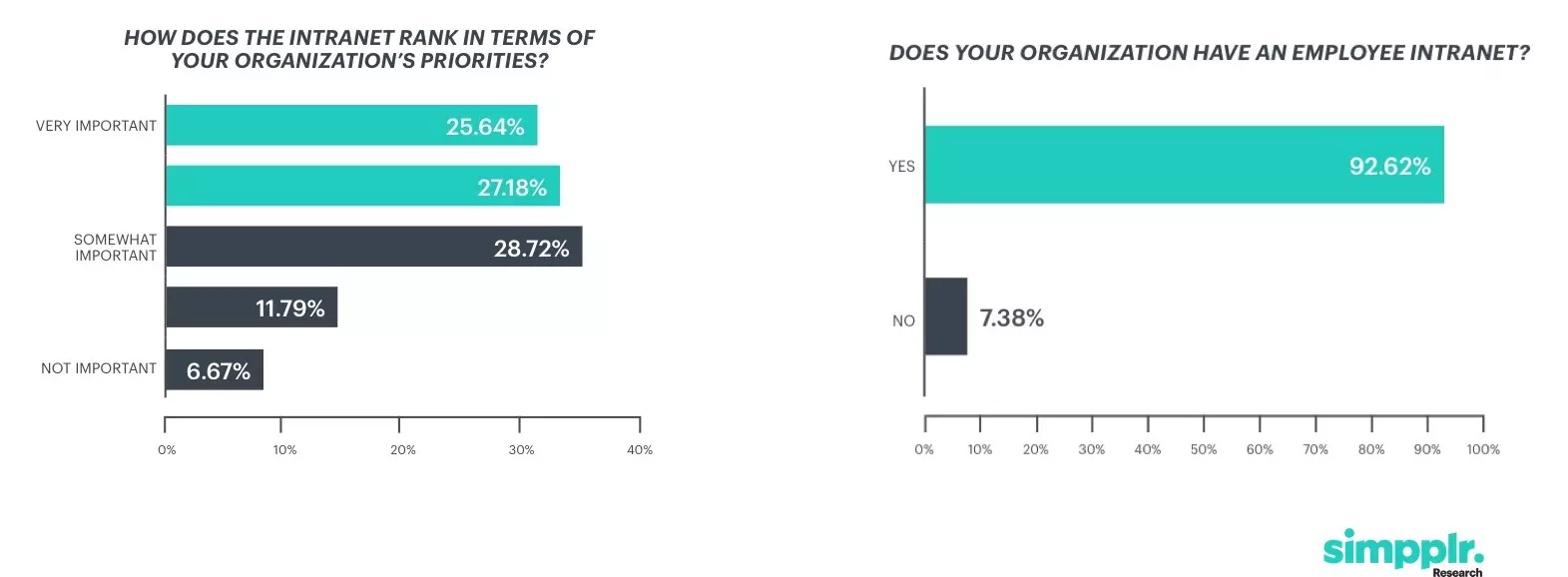Simpplr Research just concluded our latest report, State of Internal Communications 2019. The goal of the survey was to gauge the state of internal communications (IC) profession and help organizations gain insights on how to improve their IC programs. This week, Simpplr Research shares insights on how the intranet is prioritized in organizations and helps you benchmark your own IC program.
Chart of the week: Most organizations have an intranet, few make it a priority

Data Analysis: The data in the charts above is from Simpplr Research’s State of the Intranet 2018. The left chart shows the breakdown of how intranet practitioners responded to the question: “How does the intranet rank in terms of your organization’s priorities?” The right chart shows the percentage of organizations that have an employee intranet. This chart shows that the overwhelming majority (92.62%) of organizations have an employee intranet. However, analyzing the left graph, only a few organizations make their employee intranet a priority for their organization. Around 50% of organizations said that their employee intranet was at most “somewhat important” in terms of organizational priorities. Comparatively, only a quarter responded that their employee intranet was “very important” to their organization’s internal communications strategy. This is particularly concerning given that the research shows that intranet quality and governance are important both for the success of the intranet itself and for the success of an organization’s overall internal communications function.
Only 50% of organizations prioritize their intranets
The chart above surveys organizations of all sizes and asks, “How does your intranet rank in terms of your organization’s priorities?” Of all respondents, 92% of organizations have an existing corporate intranet. However, only about 50% of the organizations prioritize and invest in their corporate intranets. This implies that:
- Companies either don’t understand the impact intranets have on their internal communications program or
- Organizations don’t have an effective IC program
In Simpplr Research’s State of Internal Communications report, we found that adopting an intranet as a part of the company strategy is crucial for internal communications success. In addition, we found that the most effective technology to promote internal communications is the intranet. Organizations that have leading IC programs use an employee intranet and use it as an effective vehicle for communications.
Why internal comms should prioritize the intranet
The purpose of the internal communications function is to connect, align, and engage the entire workforce. Most internal communicators align their function to improving employee engagement, which is critical for the overall health of a company. There are many benefits to improved employee engagement, including:
- Reducing employee turnover
- Helping recruit top talent
- Improving employee productivity
- Increasing innovation in the workplace
- Boosting employee happiness
- Improving employer brand
Investing in your intranet means you take your intranet seriously as a tool to promote employee engagement. As an internal communicator, it is your job to make sure that you position the intranet strategically so that it aligns with strategic initiatives from the executive team so that you’re able to bridge the gap between your upper management and the rest of your employees.
So how do you prioritize the intranet?
Prioritizing the intranet in your own to-do list isn’t enough. Because the intranet impacts the entire organization and success require company-wide engagement, it’s vital to engage people starting from the top-down.
- First, build a case for why it’s critical to the organization and how it aligns with the internal communications function.
- Next, form a governance committee that will oversee the intranet to guarantee its success by involving stakeholders and making them accountable. The governance committee should be the main stakeholders who should agree and decide on the purpose of the intranet and how it should be used.
- Last but not least, engage your executives. Buy-in isn’t enough. Leaders need to demonstrate that they support the internal communications function in aligning the organization. We know it’s not easy, but we have exceptional best practices webinar on how to engage your leadership.
If you’re just starting out and planning an intranet project, make sure that you define the intranet’s purpose. Frequently, intranets fail because they lack a clear purpose. To avoid the top 10 reasons for intranet failure, download our eBook: Top Reasons Intranets Fail.

















